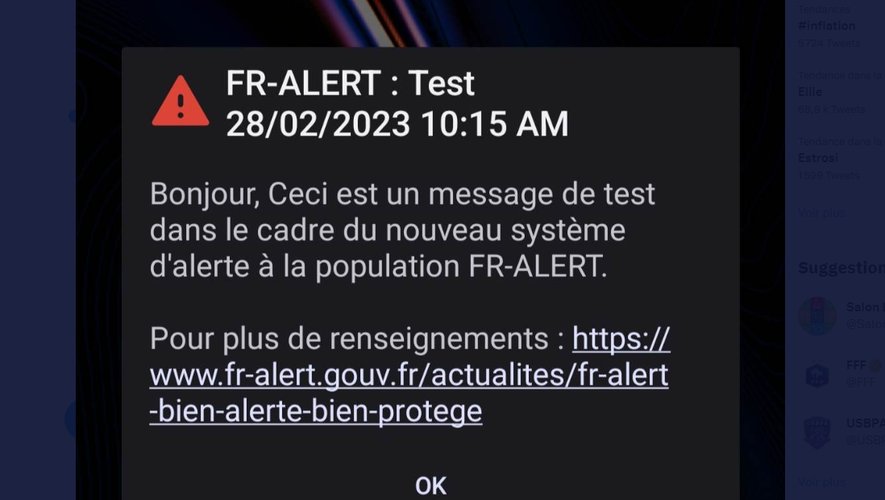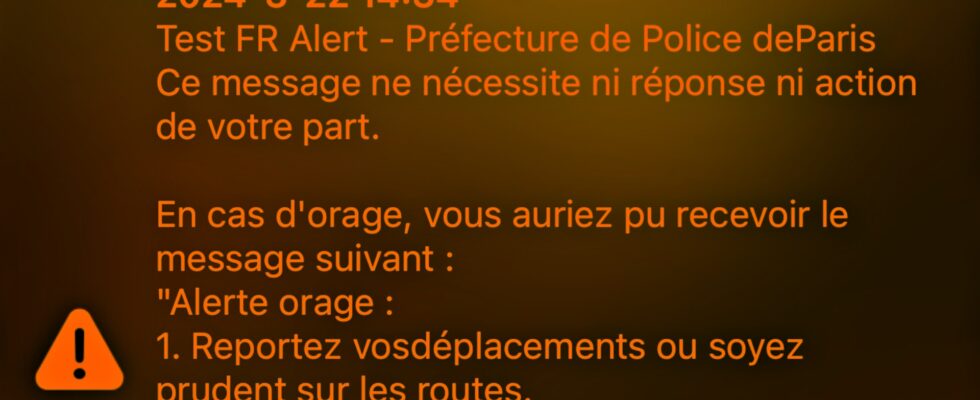If you received an alert notification on March 22, 2024, this is normal: you participated in a technical test for the implementation of a new system intended to warn the population in the event of serious danger.
If you were in the 15th arrondissement of Paris on March 22, 2024, you may have had a heart attack when you received a noisy message. The notification mentions a new alert system for the population, decorated with a red warning pictogram and an intimidating text written in capital letters: FR-ALERT. During storms in the summer of 2023, the device was used for the first time.
However, by reading the message carefully, there is no need to worry: it is in fact a technical test to verify the proper functioning of this alert system, to ensure that it will be operational on the day it is necessary. ‘enable. This is not the first time that Civil Security or the government has used it, specifying that no particular action from the public is required.
It should be noted that other tests of this type are to be expected, led by the Digital Directorate of the Ministry of the Interior, with the assistance of mobile telephone operators. In Paris, the next test will take place on April 23.
What does an FR-Alert message look like?
If an FR-Alert message is received, the smartphone emits a “ specific sound signal ”, distinct from the usual ringtones, to get the owner’s attention. This sound plays even if the smartphone is set to silent mode. The smartphone also vibrates. There are two exceptions: if the mobile is turned off or if it is in airplane mode.

A message is displayed on the screen, even if it is locked, in order to communicate information on the reasons for this message and the action to take. The text obviously varies on a case-by-case basis, depending on the nature of the threat. It can be mentioned the type of risk, its location, the authority originating the alert as well as a link if additional information needs to be transmitted.
When is an FR-Alert signal triggered?
FR-Alert notifications should only be used in the event of major danger in France and for the population. This includes natural disasters (such as a flood, wildfire or storm), industrial accidents (gas leak, pollution, nuclear incident), health hazards (pandemic) and public safety emergencies (terrorist attack ).
These alerts are also triggered around the location where the crisis situation is identified. This of course varies depending on the crisis: a forest fire has a relatively local impact. A storm can have a departmental or even regional impact. As for a pandemic, we saw it with the coronavirus: its effects can occur on the scale of a nation, or even the world.
In other words, if the public authorities consider that triggering FR-Alert is justified in Corsica because the island is ravaged by fires, only mobiles in the area will be notified. People in Brittany, Paris or the east of the country will not be notified. The choice of the geographical area to cover with these alerts is political and depends on the nature of the threat.
How does the FR-Alert system work?
The main advantage of the FR-Alert system is that it does not require the installation of a mobile application beforehand, which removes a first constraint to effectively reach a maximum number of individuals in a given area. Going through an app constitutes a barrier limiting the adoption rate: we saw this with SAIP, the ancestor of FR-Alert, and with TousAntiCovid.
To the public, notifications look like text messages. On a technical level, it is in fact a cellular broadcast (or “cell broadcast” in English). These are alert messages carried by radio waves, from relay antennas which are scattered throughout the country. These relay antennas then contact all the smartphones located nearby.
Already used successfully in other countries, the cell broadcast does not require much, in short: for individuals, it is enough to have a smartphone turned on and to be in the geographical area concerned. There is also no need to first register on a list to obtain information. Here too, it’s one less barrier to entry.
On the other hand, the decision to trigger FR-Alert is political, depending on what is happening in the country. Once the decision is made to send a notification, a message is written on a dedicated portal. Mobile telephone operators use it to relay it on their network, in the selected areas. This is, in broad terms, how FR-Alert works.
Notable point: as these are not SMS, but messages propagated by cell broadcast, FR-Alert is less exposed to congestion in the telephone network. However, this is very important: in the event of a major danger, we can expect saturation of the lines, due to occasional overload, or destroyed infrastructure.
Do alerts reach everyone?
The objective of FR-Alert is not to warn the entire French population of each serious danger situation, but only individuals found in the danger zone. For this, the option of cellular broadcasting appears much more effective than the mobile application (which you must know and install) or the alert list (which you must subscribe to).
Initially, this cellular broadcasting device was limited to smartphones equipped with 4G and 5G, which only reached 84% of the population (more than eight out of ten people have a smartphone in France). Since the end of 2022, it has also been extended to devices operating in 2G and 3G, which covers 94% of the population.
There may still be places in the territory that are still in white zones, where we do not even receive 2G. But these spaces are becoming increasingly rare. According to the telecoms regulator, Orange, SFR, Free Mobile and Bouygues Telecom cover at least 96% of the territory with 2G/3G and more than 99% of the population (due to urban concentration).
Subscribe to Numerama on Google News so you don’t miss any news!
